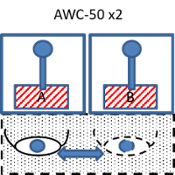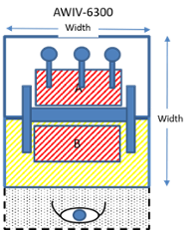Designed on the principles of lean manufacturing to reduce waste and improve workflow, robotic arc welding workcells can provide accuracy, reliability, versatility and speed for many industrial applications spanning diverse industries. While some manufacturers would argue the most efficient robotic workcell on the market is the one with the smallest footprint, there are other factors to consider. Which leads us to the question: what is the most efficient use of valuable floorspace?
In order for manufacturers to gain maximum return on investment (ROI) over a given payback period, it is imperative to use the most efficient workcell possible for handling a given application and part type. Recent buying trends suggest that the purchase of a larger robotic workcell with additional robots can be a more productive solution for a company to increase throughput and improve product quality, fulfilling labor shortages and meeting customer demands in the process.
While many Asian-based manufacturers stress a robotic workcell with a small footprint is best, companies in the U.S. have generally been less concerned with floorspace. This mentality is changing, however, as manufacturers seek to fulfill initiatives for increased productivity. Yaskawa makes a variety of standard welding workcells, which are part of the ArcWorld®series. These cells can be used to illustrate six factors that contribute to floorspace productivity. In turn, these factors can also help explain recent buying trends and evaluate the driving motivator for getting more productivity from factory floorspace.
Six Key Factors to Consider:
The answer to workcell efficiency may rest in comparing certain factors and reviewing simple ratios. To evaluate robotic workcell productivity, manufacturers should consider the following:
- Part Area
The part area is simply the space that is needed to support a product. For example, an automotive seat supplier has an obvious size difference between recliner brackets, front seats and 60/40 split rear seat frames for sub-assembly. Having enough part area to effectively and efficiently produce quality parts with tooling is key. Positioning the parts is also a factor. If the part needs to be re-oriented, it will need a larger three dimensional volume.
- Workcell Area
This refers to the size of the entire workcell footprint, or how much floorspace on the factory floor the robotic system encompasses. Manufacturers may view smaller cells as a more efficient use of floorspace. While the footprint of the cell is a valid concern to consider, choosing a robotic system based on footprint alone is not ideal. Likewise, single station workcells should be evaluated as a pair when comparing them to a two station cell.
- Safety Area
An open space, where an operator must vacate during positioner indexing to be compliant with safety regulations, is known as the safety area. Some manufacturers will customize a robotic workcell with roll-up doors to minimize the safety area space. Suspending part bins for smaller parts inside this area helps utilize this space and improve ergonomics.
- Operator / Parts Storage Area
The operator area refers to the space where the operator grabs or places parts into the cell tooling. Cells with safety space can potentially crowd an operator with part storage, which would require a single station workcell to be equipped with a wider aisle. Single station workcells are sometimes placed opposing each other, so the operator loads one and then services the cell on the opposite side of the aisle.
- Robot Quantity
The number of arc welding robots – or “arcs” referring to working torches – in a workcell is also paramount when choosing a robotic solution. Adding a second or third robot can nearly double or triple welding production with little to no impact on floorspace. This is increasing the “arc density” of a given workcell.
- Cost
Price of the workcell is considered at any stage of the design and implementation. Many times, the robot is a smaller percentage of the cost when positioners, cell controls and tooling are included. Other items, such as laser sensors, could also increase cost but improve cycle time. A customer’s part and throughput requirements will dictate how much they may value these cost-adding features when creating an extremely efficient cell.
Application
When choosing the most productive workcell for a given application and part type, manufacturers should evaluate key factors that impact workcell efficiency as comparisons. For example:
- Part Area / Workcell Area = Part to Workcell Area Ratio
- Part / Workcell X Arc Robot Qty = Arc Density or Workcell Productivity Ratio
- Ratio of $ to Floorspace and # of Arcs = Value Ratio
- Integration Costs (1x per workcell): PLC +HMI + Power Drops + Tooling + Etc.

Example 1: A job shop or automotive company may consider the ArcWorld C-52 (AWC-52), which is a compact workcell for low- to medium-volume fabrication that has two flat table stations (an AWC-52S has headstocks for turning parts). This cell delivers a powerful performance in a compact package, featuring:
- Reduced floorspace
- One six-axis Motoman® robot
- Roll-up door
- Integrated welding package
- Max part size (mm) 760 x 700 capacity
Selecting a smaller workcell based on part size may appear to be the best use of floorspace, but after considering the smaller part size in conjunction with the total footprint of the workcell, the overall area efficiency of this cell is only 12%.
In assessing the cell’s production capacity, the number of arc welding robots was evaluated as well. After calculating the part area to robot ratio and comparing it to the number of arcs, it was determined that the AWC-52 workcell productivity ratio was still 12% efficient due to the single robot. Despite low entry cost, fast ramp-up time, tight footprint design and easy safeguarding capabilities, this workcell may fall short for some manufacturers as comparisons are made.
Similarly, compact single station workcells should be evaluated as a pair, compared to a two station cell. This type of configuration adds an extra arc welding robot to the process, but also it adds more space to the operator area. While this workcell eliminates the sweep time of a positioner, it forces the operator to walk, offering poor ergonomics and potentially increasing cycle time.
 Some manufacturers will locate these cells facing each other, where the operator space is tended by a single operator. This can drive the productivity ratio up to 30% based on two robots and the part/workcell area. The use of two cells will result in 2x the integration cost, which can be significant for automotive manufacturers with automated tooling.
Some manufacturers will locate these cells facing each other, where the operator space is tended by a single operator. This can drive the productivity ratio up to 30% based on two robots and the part/workcell area. The use of two cells will result in 2x the integration cost, which can be significant for automotive manufacturers with automated tooling.
Example 2: Manufacturers looking for a workcell to weld smaller parts that do not require positioning may consider the larger ArcWorld 1000 (single robot configuration) or ArcWorld 1200 (dual robot configuration). Pre-engineered for small- to medium-sized part production for medium-to high-volume welding applications, these ArcWorlds feature:
- High-speed servo turntable (60 in or 72 in table top)

- One or two six-axis Motoman robots
- Functional Safety Unit (FSU)
- Integrated welding package
- Max part size (mm) 1,000 x 474 capacity
Using the same sub-assembly comparison (see Example 1), the AW1000 cell was found to be 10% efficient using the part area to workcell area ratio. Despite the introduction of a high-speed servo turntable, the presence of the safety area created “dead space” that was unusable during operation. On the positive side, the operator area required minimal movement from the operator, creating better ergonomics.
When the arc density was calculated in relation to the part area to workcell area ratio, it revealed that the addition of an extra arc welding robot in this configuration (AW1200) increased the overall workcell productivity to 19%. When comparing the list prices between other ArcWorld workcells, the AW1200 represents the lowest price/arc of all the workcells, making it a good value. There is only 1x integration cost for this cell.

Example 3: Our most popular workcell, the AWIV-6000 series with ferris wheel positioner, provides the most efficient use of floorspace. Pre-engineered for medium- to high-volume part production, these feature:
- High-speed capacity, space-saving slim-line positioner
- One, two, three or four six-axis Motoman robots
- Functional Safety Unit (FSU)
- Integrated welding package
- Max part size (mm) 4,000 and 1,525 capacity
Using the same floorspace efficiency comparison (see Example 1 and Example 2), the ArcWorld IV-6000 series cells were found to be 30-34% efficient using the part area to workcell area ratio. While the addition of a high-speed, slim-line positioner in relation to the part area and workcell area increased the efficiency of the cell, the presence of the safety area still created “dead space” that was unusable during operation. Some manufacturers have used roll-up curtains to span the safety area to reduce the distance used by light curtains.
As in the ArcWorld C-series and ArcWorld 1000 series workcell examples, the presence of arc welding robots boosted the productivity factor of each cell. When the arc density was calculated in relation to the part area to workcell area ratio for each cell in the ArcWorld IV-6000 series, the findings were as follows:
- AWIV-6000SL part area / workcell X 1 arc robot = 60% productivity ratio
- AWIV-6200SL part area / workcell X 2 arc robots = 67% productivity ratio
- AWIV-6300SL part area / workcell X 3 arc robots = 100% productivity ratio
The arc density in relation to the part area to workcell ratio gave the ArcWorld IV-6300SL a greater percentage, making it the most flexible and productive workcell in our standard configurations.
A repeat customer has changed from specifying AWIV-6300 cells with 3 robots and 3-meter positioner spans to cells with four robots (AWIV-6400) and 4-meter positioner spans. Although this slightly improves the customer’s part area to cell area (floorspace efficiency) from 34% to only 36%, the arc density ratio (or productivity efficiency) increases greatly from 101% to 143%. In addition, adding more robots is a cost-effective solution because cell integration costs, such as PLC’s, HMI’s, tooling, safeguarding and utility drops, do not increase.
Conclusion:
Compact robotic workcells offer a reduced footprint, but they are not necessarily the most efficient use of floorspace. Job shops may want to evaluate the part size capacity in relation to the workcell footprint to determine the most FLEXIBLE use of floorspace. Moreover, in an effort to increase the PRODUCTIVITY of floorspace, automotive companies may want to consider expanding the work area slightly to add more robots. Evaluating the cost of a couple, different workcell configurations, including integration costs, can help manufacturers make sure they are maximizing the VALUE of their floorspace.